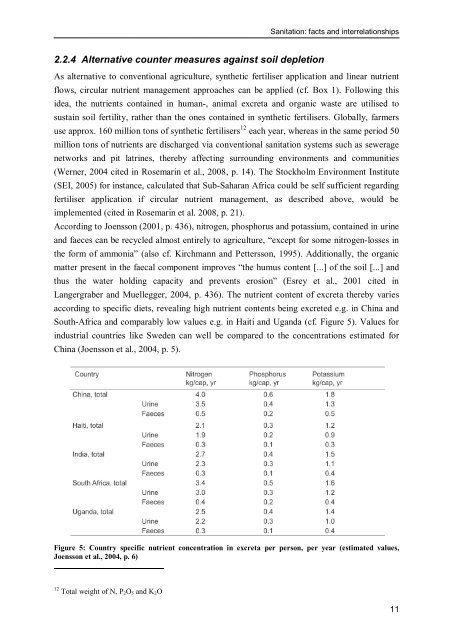Economic Effects of Sustainable Sanitation - SuSanA
Economic Effects of Sustainable Sanitation - SuSanA
Economic Effects of Sustainable Sanitation - SuSanA
You also want an ePaper? Increase the reach of your titles
YUMPU automatically turns print PDFs into web optimized ePapers that Google loves.
2.2.4 Alternative counter measures against soil depletion<br />
<strong>Sanitation</strong>: facts and interrelationships<br />
As alternative to conventional agriculture, synthetic fertiliser application and linear nutrient<br />
flows, circular nutrient management approaches can be applied (cf. Box 1). Following this<br />
idea, the nutrients contained in human-, animal excreta and organic waste are utilised to<br />
sustain soil fertility, rather than the ones contained in synthetic fertilisers. Globally, farmers<br />
use approx. 160 million tons <strong>of</strong> synthetic fertilisers 12 each year, whereas in the same period 50<br />
million tons <strong>of</strong> nutrients are discharged via conventional sanitation systems such as sewerage<br />
networks and pit latrines, thereby affecting surrounding environments and communities<br />
(Werner, 2004 cited in Rosemarin et al., 2008, p. 14). The Stockholm Environment Institute<br />
(SEI, 2005) for instance, calculated that Sub-Saharan Africa could be self sufficient regarding<br />
fertiliser application if circular nutrient management, as described above, would be<br />
implemented (cited in Rosemarin et al. 2008, p. 21).<br />
According to Joensson (2001, p. 436), nitrogen, phosphorus and potassium, contained in urine<br />
and faeces can be recycled almost entirely to agriculture, ―except for some nitrogen-losses in<br />
the form <strong>of</strong> ammonia‖ (also cf. Kirchmann and Pettersson, 1995). Additionally, the organic<br />
matter present in the faecal component improves ―the humus content [...] <strong>of</strong> the soil [...] and<br />
thus the water holding capacity and prevents erosion‖ (Esrey et al., 2001 cited in<br />
Langergraber and Muellegger, 2004, p. 436). The nutrient content <strong>of</strong> excreta thereby varies<br />
according to specific diets, revealing high nutrient contents being excreted e.g. in China and<br />
South-Africa and comparably low values e.g. in Haiti and Uganda (cf. Figure 5). Values for<br />
industrial countries like Sweden can well be compared to the concentrations estimated for<br />
China (Joensson et al., 2004, p. 5).<br />
Figure 5: Country specific nutrient concentration in excreta per person, per year (estimated values,<br />
Joensson et al., 2004, p. 6)<br />
12 Total weight <strong>of</strong> N, P2O5 and K2O<br />
11

















